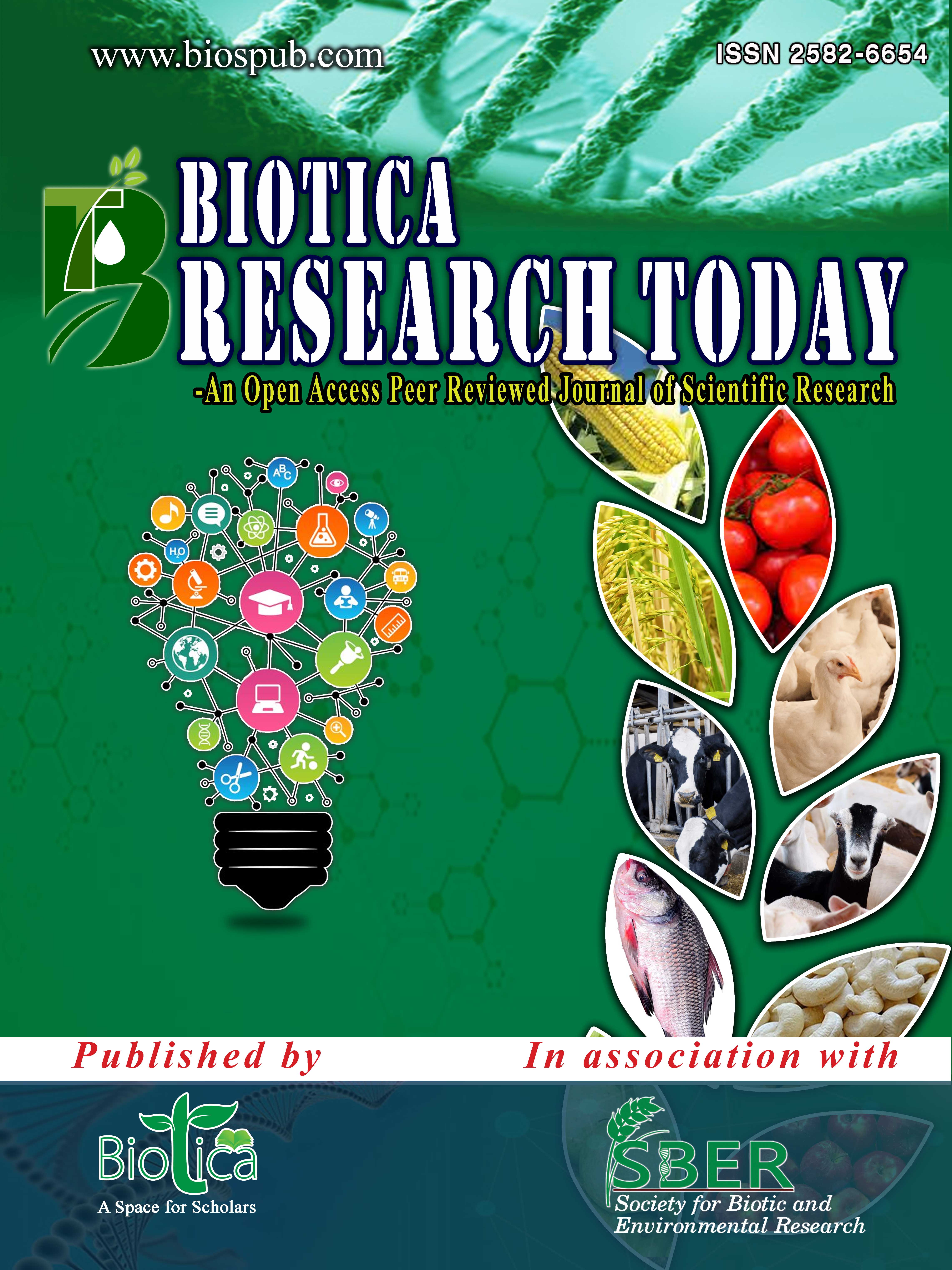Native Diversity of Endotrophic Mycorrhizal Fungi of Forage Grass Species Occurring in Asan River Basin, Mussoorie Hills, Uttarakhand
DOI:
https://doi.org/10.54083/PHA/1.3.2023/73-81Keywords:
Abiotic stress, Arbuscular mycorrhiza, Mycorrhizal symbiosis, Plant microbe interaction, Root colonization, Spore countAbstract
Arbuscular Mycorrhizal (AM) fungi colonize more than 80% of plants on land in which grasses are known to have higher endomycorrhizal colonization. AM fungi are a common group of symbiotic fungi in the order, Glomale of Division, Zygomycota. These fungi are known to benefit growth through increased nutrient uptake especially phosphorus. In this study, a total of 21 grass species collected from the Asan river basin, Mussoorie hills, Dehradun, Uttarakhand were screened for AM fungal root colonization and their mycorrhizal diversity. Traditional method of sieving and decanting was used for isolating mycorrhizal spores whereas for studying colonization rapid staining and clearing method was used. The highest root colonization (95±2.9) and AM spore count (234±3.56) were observed in Phalaris minor whereas Saccharum spontaneum exhibited least colonization (30±0.53) and AM spore count (46.7±14.5), respectively. The Andropogoneae (Sorghum tribe) was observed to be the most diverse tribe in association with endomycorrhizal fungi among the studied grasses. This study confirms that the grass species are highly colonized and dependent on endomycorrhizal association. The diversity and colonization patterns of endotrophic mycorrhizal fungi are described in details in this research paper. The AM fungal association with grass species provides new vistas and insight on the functioning of any grass ecosystem and also helps in harnessing the benefits of AM fungi through their usage in waste and abundant land reclamation programmes.
Downloads
References
Bonfante, P., Genre, A., 2010. Mechanisms underlying beneficial plant-fungus interactions in mycorrhizal symbiosis. Nature Communications 1, 48. DOI: 10.1038/ncomms1046. DOI: https://doi.org/10.1038/ncomms1046
Brundrett, M., 1991. Mycorrhizas in natural ecosystems. In: Advances in Ecological Research. Volume 21. (Eds.) Begon, M., Fitter, A.H. and Macfadyen, A. Academic Press. pp. 171-313. DOI: 10.1016/S0065-2504(08)60099-9. DOI: https://doi.org/10.1016/S0065-2504(08)60099-9
Brundrett, M., 2004. Diversity and classification of mycorrhizal associations. Biological Reviews 79(3), 473-495. DOI: 10.1017/S1464793103006316. DOI: https://doi.org/10.1017/S1464793103006316
Candido, V., Campanelli, G., D’Addabbo, T., Castronuovo, D., Perniola, M., Camele, I., 2015. Growth and yield promoting effect of artificial mycorrhiza on field tomato at different irrigation regimes. Scientia Horticulturae 187, 35-43. DOI: 10.1016/j.scienta.2015.02.033. DOI: https://doi.org/10.1016/j.scienta.2015.02.033
Chen, X., Liu, Y., Liu, H., Wang, H., Yang, D., Huangfu, C., 2015. Impacts of four invasive Asteraceae on soil physico-chemical properties and AM fungi community. American Journal of Plant Sciences 6(17), 2734-2743. DOI: 10.4236/ajps.2015.617274. DOI: https://doi.org/10.4236/ajps.2015.617274
Daei, G., Ardekani, M.R., Rejali, F., Teimuri, S., Miransari, M., 2009. Alleviation of salinity stress on wheat yield, yield components and nutrient uptake using arbuscular mycorrhizal fungi under field conditions. Journal of Plant Physiology 166(6), 617-625. DOI: 10.1016/j.jplph.2008.09.013. DOI: https://doi.org/10.1016/j.jplph.2008.09.013
Gaur, A., Adholeya, A., 1994. Estimation of VAM fungal spores in soil: a modified method. Mycorrhiza News 6(1), 10-11.
Gerdemann, J.W., Nicolson, T.H., 1963. Spores of mycorrhizal endogone species extracted from soil by wet sieving and decanting. Transactions of the British Mycological Society 46(2), 235-244. DOI: 10.1016/S0007-1536(63)80079-0. DOI: https://doi.org/10.1016/S0007-1536(63)80079-0
Gianinazzi-Pearson, V., Diem, H.G., 1982. Endomycorrhizae in the tropics. In: Microbiology of Tropical Soils and Plant Productivity. (Eds.) Dommergues, Y.R. and Diem, H.G. Developments in Plant and Soil Sciences, Volume 5. Springer, Dordrecht. pp. 209-251. DOI: 10.1007/978-94-009-7529-3_8. DOI: https://doi.org/10.1007/978-94-009-7529-3_8
Hart, M.M., Reader, R.J., 2002. Taxonomic basis for variation in the colonization strategy of arbuscular mycorrhizal fungi. New Phytologist 153(2), 335-344. DOI: 10.1046/j.0028-646X.2001.00312.x. DOI: https://doi.org/10.1046/j.0028-646X.2001.00312.x
Hoeksema, J.D., Chaudhary, V.B., Gehring, C.A., Johnson, N.C., Karst, J., Koide, R.T., Pringle, A., Zabinski, C., Bever, J.D., Moore, J.C., Wilson, G.W.T., Klironomos, J.N., Umbanhowar, J., 2010. A meta-analysis of context-dependency in plant response to inoculation with mycorrhizal fungi. Ecology Letters 13(3), 394-407. DOI: 10.1111/j.1461-0248.2009.01430.x. DOI: https://doi.org/10.1111/j.1461-0248.2009.01430.x
Jain, S., 2007. Use of IKONOS satellite data to identify informal settlements in Dehradun, India. International Journal of Remote Sensing 28(15), 3227-3233. DOI: 10.1080/01431160600705122. DOI: https://doi.org/10.1080/01431160600705122
Javaid, A., Bajwa, R., Tasneem, Z., Nasim, G., 1995. Vescicular Arbuscular Mycorrhizae in allelopathic and non-allelopathic grasses. Science International (Lahore) 7(4), 547-547.
Jeffries, P., Barea, J.M., 2012. Arbuscular Mycorrhiza: A key component of sustainable plant-soil ecosystems. In: Fungal Associations. (Ed.) Hock, B. The Mycota, Volume 9. Springer, Berlin, Heidelberg. pp. 51-75. DOI: https://doi.org/10.1007/978-3-642-30826-0_4
Marx, D.H., 1975. Mycorrhizae and establishment of trees on strip-mined land. The Ohio Journal of Science 75(6), 288-296.
Morton, J.B., Benny, G.L., 1990. Revised classification of arbuscular mycorrhizal fungi (Zygomycetes): A new order, Glomales, two new suborders, Glomineae and Gigasporineae, and two new families, Acaulosporaceae and Gigasporaceae, with an emendation of Glomaceae. Mycotaxon 37, 471-491.
Morton, J.B., Redecker, D., 2001. Two new families of Glomales, Archaeosporaceae and Paraglomaceae, with two new genera Archaeospora and Paraglomus, based on concordant molecular and morphological characters. Mycologia 93(1), 181-195. DOI: 10.1080/00275514.2001.12063147. DOI: https://doi.org/10.1080/00275514.2001.12063147
O’Keefe, D.M., Sylvia, D.M., 1991. Mechanisms of the vesicular-arbuscular mycorrhizal plant growth response. In: Handbook of Applied Mycology. (Eds.) Arora, D.K., Bharat, R., Mukerji, K.G., Kundsen, G.R. Soil and Plants, Volume 1. Marcel-Dekker Inc., New York. pp. 35-53.
Pérez, Y., Schenck, N.C., 1990. A unique code for each species of VA mycorrhizal fungi. Mycologia 82(2), 256-260. DOI: 10.1080/00275514.1990.12025872. DOI: https://doi.org/10.1080/00275514.1990.12025872
Phillips, J.M., Hayman, D.S., 1970. Improved procedures for clearing roots and staining parasitic and vesicular-arbuscular mycorrhizal fungi for rapid assessment of infection. Transactions of the British Mycological Society 55(1), 158-161. DOI: 10.1016/S0007-1536(70)80110-3. DOI: https://doi.org/10.1016/S0007-1536(70)80110-3
Read, D.J., 1991. Mycorrhizas in ecosystems. Experientia 47(4), 376-391. DOI: https://doi.org/10.1007/BF01972080
Rhodes, L.H., Gerdemann, J.W., 1975. Phosphate uptake zones of mycorrhizal and non-mycorrhizal onions. New Phytologist 75(3), 555-561. DOI: 10.1111/j.1469-8137.1975.tb01419.x. DOI: https://doi.org/10.1111/j.1469-8137.1975.tb01419.x
Sanders, F.E., Tinker, P.B., 1973. Phosphate flow into mycorrhizal roots. Pesticide Science 4(3), 385-395. DOI: https://doi.org/10.1002/ps.2780040316
Sathiyadash, K., Muthukumar, T., Uma, E., 2010. Arbuscular mycorrhizal and dark septate endophyte fungal associations in south Indian grasses. Symbiosis 52(1), 21-32. DOI: 10.1007/s13199-010-0096-9. DOI: https://doi.org/10.1007/s13199-010-0096-9
Sharma, D., Kapoor, R., Bhatnagar, A.K., 2009. Differential growth response of Curculigo orchioides to native arbuscular mycorrhizal fungal (AMF) communities varying in number and fungal components. European Journal of Soil Biology 45(4), 328-333. DOI: 10.1016/j.ejsobi.2009.04.005. DOI: https://doi.org/10.1016/j.ejsobi.2009.04.005
Sharma, D., Kapoor, R., Bhatnagar, A.K., 2008. Arbuscular mycorrhizal (AM) technology for the conservation of Curculigo orchioides Gaertn.: An endangered medicinal herb. World Journal of Microbiology and Biotechnology 24(3), 395-400. DOI: 10.1007/s11274-007-9488-2. DOI: https://doi.org/10.1007/s11274-007-9488-2
Singh, O., Arya, P., Chaudhary, B.S., 2013. On rising temperature trends at Dehradun in Doon valley of Uttarakhand, India. Journal of Earth System Science 122(3), 613-622. DOI: 10.1007/s12040-013-0304-0. DOI: https://doi.org/10.1007/s12040-013-0304-0
Smith, S.E., Read, D.J., 2008. Mycorrhizal Symbiosis. Academic Press. p. 800.
Sreenivasa, M.N., Bagyaraj, D.J., 1989. Use of pesticides for mass production of vesicular-arbuscular mycorrhizal inoculum. Plant and Soil 119(1), 127-132. DOI: 10.1007/BF02370276. DOI: https://doi.org/10.1007/BF02370276
Srivastava, D., Kapoor, R., Srivastava, A.K., Mukerji, K.G., 1996. Vesicular arbuscular mycorrhiza - An overview. In: Concepts in Mycorrhizal Research. (Ed.) Mukerji, K.G. Kluwer Press, Dordrecht. pp. 1-34. DOI: https://doi.org/10.1007/978-94-017-1124-1_1
Taber, R.A., Trappe, J.M., 1982. Vesicular-arbuscular mycorrhiza in rhizomes, scale-like leaves, roots and xylem of ginger. Mycologia 74(1), 156-161. DOI: 10.1080/00275514.1982.12021485. DOI: https://doi.org/10.1080/00275514.1982.12021485
Tahira, J.J., Khan, S.N., Anwar, W., Suliman, R., 2012. Mycorrhizal association in some weeds of Curcuma longa fields of district Kasur, Pakistan. Pakistan Journal of Weed Science Research 18(3), 91-97.
van der Heijden, M.G.A., Klironomos, J.N., Ursic, M., Moutoglis, P., Streitwolf-Engel, R., Boller, T., Wiemken, A., Sanders, I.R., 1998. Mycorrhizal fungal diversity determines plant biodiversity, ecosystem variability and productivity. Nature 396, 69-72. DOI: 10.1038/23932. DOI: https://doi.org/10.1038/23932
Walker, C., 1992. Systematics and taxonomy of the arbuscular endomycorrhizal fungi (Glomales) - A possible way forward. Agronomie 12, 887-897. DOI: 10.1051/agro:19921026. DOI: https://doi.org/10.1051/agro:19921026
Downloads
Published
How to Cite
Issue
Section
License
Copyright (c) 2023 Plant Health Archives

This work is licensed under a Creative Commons Attribution-NonCommercial-NoDerivatives 4.0 International License.
Submission of a manuscript implies that when the manuscript is accepted for publication, the authors agree to automatic transfer of the copyright to the publisher (or grant the Publisher exclusive publication and dissemination rights). The Biotica, as the publisher, has the right to enter into any agreement with any organization in India or abroad engaged in reprography, photocopying, storage and dissemination of information contained in this journal. The Biotica has no objection in using the material, provided the information is being utilized for academic purpose but not for commercial use. Due credit line should be given to Biotica where information will be utilized.









 |
|




